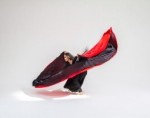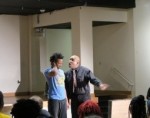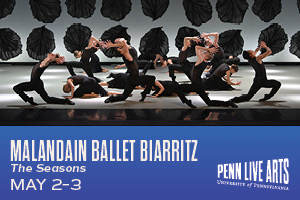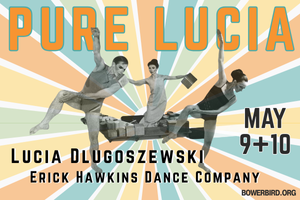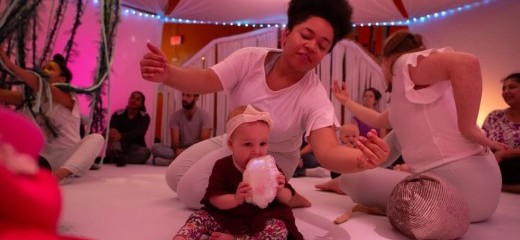
A Planet Made Soft
by Jenna Horton
It’s common lore in theatre never to put a baby onstage. They’re entirely unpredictable and will always steal the show. Instead of chucking the baby out of the theatre, Homeworld, Ninth Planet’s new performance installation for babies and their caregivers, wraps its arms around these truths so fully it achieves a wild and tender success.
The first encounter with Homeworld shows its ethos already in play. An experience host, who will guide us through the entire journey, meets caregivers and children at the door with baby snacks, water, instructions, and an assuring tone. A list of core values stands by for a curious eye (“the word ‘wrong’ does not exist” and “enjoy the world, but also respect the world,” amongst others). Childcare is provided for siblings over 18 months, who have outgrown the scale and design of this particular performance installation. The bathrooms are gender neutral. Oh, and did I mention, it’s all FREE. Not to make, mind you, but has intentionally been made accessible. Care emanates.
Homeworld takes place in a circular tent—a big top made small. Once filled with, say, ten babies and their doting fifteen-ish-or-so caregivers. This tent-crib-fort holds more oxygen, more baby beings, and more adult eyes than any womb, yet it echoes the fluid, watery chambers from whence we all came, when we didn’t know hard lines. White scrim diffuses light. Foam pads the floor. Shoes are not allowed. Crawling, burping, and being are.
Rendering an underwater world, plushy globular pillows stand in for rocks, a clam, a coral, which populate the tent/sea floor. The newly welcomed organisms—caregivers and babies—organize themselves, loosely hugging the outskirts of the tent. Out of some of these sewn shapes emerge Nia Benjamin, Eliana Fabiyi, and Tess Kunik.
I appreciate their focus—simple and attentive, not loud or overeager. They don’t perpetuate a manic quality adults sometimes have when approaching babies (it’s in the eyeballs or the high-pitched voice—the thirsting need for a smile, a reaction, ANYTHING from this very tiny and very present being). Happily, the dancers aren’t checked out performing neutral space either. No projecting the modern dance “I’m looking at nothing and you are not here” gaze glaze. Their presence is permeable, inviting their co-conspirators (hello, BABIES) into the world, and onto center stage.
All components of Homeworld coalesce to center and heighten the babies’ exploration of the world, and thus our witnessing of it. The dancers move gently. Much of their floor-based choreography—a leg held in the air, alert on a belly, a shake and a scoot—highlights the already present organic movement of ten tiny beings, now incorporated, weaving in and out, exploring the taste of a felt coral reef, gazing through the scrim towards a light, bouncing up and down in apparent glee. Growls, slurps, and gurgles occasionally escape from the performers mouths, sometimes intriguing an alert ear from across the space. A soundscape (composer Steve Hayward, sound designer Adriano Shaplin) envelops us all—a weave of light piano snoring, even bubbles, to name only a couple. At one point, the track swells into a pocket of upbeat electronica, to which the dancers reply with a vocabulary that looks like slow-motion waacking while sitting underwater (if there were such a thing!).
Homeworld’s structure expresses itself through an environment designed for a non-verbal conversation to unfold. What to pay attention to is a matter of curiosity, not coercion. Parental moments of wanting to guide (“look, it’s moving!”) or wanting to explain and narrate, come in and out, but Ninth Planet encourages a space released from narrative with fewer “should” and “shouldn’ts.” One of the greatest joys of watching this piece is the presence it requires of the adults in attendance—a generous attentiveness to everyone in the space and the unknown in-between.
I couldn’t help but think of Picasso’s painting Mother and Child, specifically how the mother holds the infant in her lap. I love the gesture of the left hand, which props the baby up, allowing a supported freedom. Crafting Homeworld, where exploration can happen with tenderness, seems to be what Ninth Planet is after, and achieves.
Homeworld, Ninth Planet. The Painted Bride, Oct 5-14
By Jenna Horton
October 22, 2018



